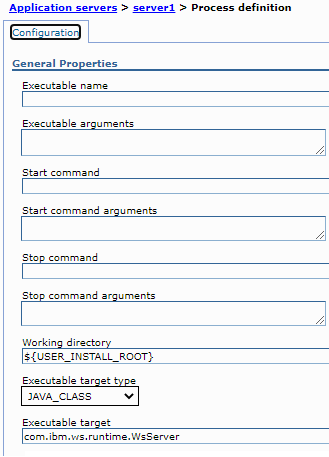Process definition settings
Configure a process definition. A process definition includes the command line information necessary to start or initialize a process.
From the admin console, click...
Servers | Server Types | WebSphere application servers | server | Server Infrastructure | Java and process management | Process definition

On z/OS we must then click Control, Servant, or Adjunct.
For z/OS, this page provides command-line information for starting, initializing, or stopping a process. Each of the commands for which information is provided can be used for the control process. Only the Start command and Start command arguments properties apply for the servant process. Specify the commands for the control process on one process definition panel and the commands for the servant process on another process definition panel. Do not specify the commands for the two different processes on the same panel.
Executable name
Executable name invoked to start the process.
For example, if we are using a perl script as a generic server, enter the path to the perl.exe module in the Executable name field, and then enter the name of the perl script, along with any arguments, in the Executable arguments field.
This field is not available for the z/OS control process.
| Information | Value |
|---|---|
| Data type | String |
(iSeries) (Dist) Executable arguments
Arguments passed to the executable when starting the process.
We can enter multiple arguments in this field, but they must be separated by carriage returns. Use the Enter key on your keyboard to create these carriage returns. The following example illustrates how a perl script application that requires two arguments should appear in this field:
perl_application.pl arg1 arg2
This field is not available for the z/OS control process.
| Information | Value |
|---|---|
| Data type | String |
| Units | Command-line arguments |
Start command (startCommand)
Platform-specific command to launch the server process.
(ZOS)
- z/OS control process
-
Information Value Data type String Format START control_JCL_procedure_name Example START BBO6ACR - z/OS servant process
-
For the z/OS servant process, the value on the start command specifies the procedure name that workload manager (WLM) uses to start the servant process. WLM only uses this value if the WLM dynamic application environment feature is installed.
Information Value Data type String Format servant_JCL_procedure_name Example BBO6ASR
Start command arguments (startCommandArgs)
Additional arguments required by the start command.
If we have two or more arguments to be passed for process definition settings, then specify the arguments on separate lines. For example, if you are specifying port 8089 and a configuration file (location and file name) as command arguments, we would specify:
<startCommandArgs>8089<startCommandArgs> <startCommandArgs>/opt/payexpert/conf/PCPILogServer.properties<startCommandArgs>In the administrative console, we specify this by entering each argument on a new line.
Do not separate the command arguments with just a space.
(ZOS)
- z/OS control process
-
Information Value Data type String Format JOBNAME=server_short_name, ENV=cell_short_name.node_short_name.server_short_name Example JOBNAME=BBOS001,ENV=SY1.SY1.BBOS001 - z/OS servant process
-
Information Value Data type String Format JOBNAME=server_short_nameS, ENV=cell_short_name.node_short_name.server_short_name Example JOBNAME=BBOS001S,ENV=SY1.SY1.BBOS001
For z/OS, the server short name (JOBNAME) contains 7 characters by default, but we can lengthen the short name to 8 characters.
Stop command (stopCommand)
Platform-specific command to stop the server process
For z/OS, if this field is left blank, then the VS STOP command is used to stop the generic server.
| Information | Value |
|---|---|
| Data type | String |
| Format | STOP server_short_name;CANCEL server_short_name |
| z/OS example | STOP BBOS001;CANCEL BBOS001 |
Stop command arguments (stopCommandArgs)
Additional arguments required by the stop command.
| Information | Value |
|---|---|
| Data type | String |
| Format | stop command arg string;immediate stop command arg string |
| z/OS example | ;ARMRESTART
In this example, Stop has no arguments. Immediate Stop has the argument ARMRESTART. A semicolon precedes ARMRESTART. |
Terminate command (terminateCommand)
Platform-specific command to terminate the server process.
| Information | Value |
|---|---|
| Data type | String |
| Format | FORCE server_short_name |
| z/OS example | FORCE BBOS001 |
Terminate command arguments (terminateCommandArgs)
Additional arguments required by the terminate command.
The default is an empty string.
| Information | Value |
|---|---|
| Data type | String |
| Format | terminate command arg string |
| z/OS example | ARMRESTART |
Work directory
File system directory that the process uses as its current working directory. This setting only applies for IBM i and distributed platforms. The process uses this directory to determine the locations of input and output files with relative path names.
This field does not display for the z/OS control process.
On z/OS, the working directory is always the UNIX System Services directory that is defined using the OMVS setting of the RACF user profile for the user that starts the servant. Therefore, even if we specify a directory in this field, the UNIX System Services directory is used as the working directory. To provide compatibility between applications that run on a z/OS platform and on a distributed platform, set the UNIX System Services directory to the same value specified for the Working directory field on your distributed platform system.
Changing the setting of com.ibm.websphere.zos.userdir.useRacfSettings will have no dynamic impact on the JVM. See Java virtual machine custom properties . .
| Information | Value |
|---|---|
| Data type | String |
Executable target type
Specifies whether the executable target is a Java class or an executable JAR file.
| Information | Value |
|---|---|
| Data type | String |
Executable target
Name of the executable target. If the target type is a Java class name, this field contains the main() method. If the target type is an executable JAR file, this field contains the name of that JAR file.
| Information | Value |
|---|---|
| Data type | String |